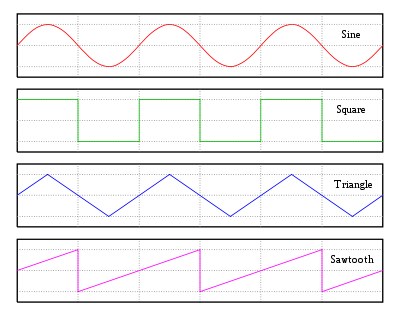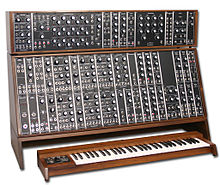- Modular synthesizer
-
The modular synthesizer is a type of synthesizer consisting of separate specialized modules connected by wires (patch cords) to create a so-called patch. Every output generates a signal – an electric voltage of variable strength. Combining the signals generated by multiple modules into a common audio output allows a potentially infinite number of configurations, leading to a potentially infinite number of sounds.
There exist many different types and sub-types of modules – even modules with the same basic function will have different inputs, outputs and controls on various models. There are some standards which manufacturers followed for their range of synthesizers; however, connecting synthesizers from different manufacturers often requires converters.
Some standard modules found on almost any modular synth are:
- VCO – Voltage Controlled Oscillator, which will output a pitched sound (frequency) in a simple waveform (most usually a square wave or a sawtooth wave, but also includes pulse, triangle and sine waves).
- Noise source - A generator that supplies "hiss" sound similar to static, which can be used for explosions, cymbals, or randomly generated control signals. Common types of noise offered by modular synthesizers include white, pink, and low frequency noise.
- VCF - Voltage Controlled Filter, which attenuates frequencies below (high-pass), above (low-pass) or both below and above (band-pass) a certain frequency. VCFs can also be configured to provide band-exclusion, whereby the high and low frequencies remain while the middle frequencies are removed.
- VCA - Voltage Controlled Amplifier, which varies the amplitude of a signal in response to a supplied control voltage.
- EG - triggering an Envelope Generator produces a single, repeatable shaped voltage pulse. Often configured as ADSR (Attack, Decay, Sustain, Release) it provides the means to shape a recognizable sound from a raw waveform. This technique can be used to synthesize the natural decay of a piano, or the sharp attack of a trumpet. It can be triggered by a keyboard or by another module in the system. Usually it drives the output of a VCA or VCF, but the patchable structure of the synthesizer makes it possible to use the envelope generator to modulate other parameters such as the pitch or pulse width of the VCO. Simpler EGs (AD or AR) or more complex (DADSR—Delay, Attack, Decay, Sustain, Release) are sometimes available.
- LFO - A Low Frequency Oscillator is similar to a VCO but it usually operates below 20 Hz. It is generally used as a control voltage for another module. For example, modulating a VCO will create vibrato while modulating a VCA will create tremolo.
- RM - Ring modulator - Two audio inputs are utilized to create sum and difference frequencies while suppressing the original signals. This gives the sound a "robotic" quality.
- Mixer - a module that combines multiple signals into one.
- S&H - Sample and hold, which takes a "sample" of the input voltage when a trigger pulse is received and "holds" it until a subsequent trigger pulse is applied. The source is often taken from a noise generator.
- Sequencer, which produces a sequence of notes, usually a music loop.
- Slew limiter - smooths off the peaks of voltages. This can be used to create glide or portamento between notes. Can also work as a primitive low-pass filter.
- Custom Control Inputs - Because modular synthesizers have voltage-driven inputs, it is possible to connect almost any kind of control. Pitch can be varied by room temperature if you wish, or amplification varied by light level falling on a sensor.
Modular synthesizers can be bulky and expensive, and there is a steep learning curve. Producing polyphonic music is painstaking and difficult, and, since patches cannot be saved, they are not easy to play live. In the late 1980s, modular synthesizers were largely replaced by highly integrated keyboard synthesizers, racks of MIDI-connected gear, and samplers. However, there continues to be a loyal following of musicians who prefer the physically patched approach, the flexibility and the sound of traditional modulars. Lately there has been a resurgence in the popularity of analog synthesizers; in fact, there are more manufacturers now than there were when they were at the height of their 1970's peak popularity.
Contents
Historic manufacturers of modular synthesizer hardware
The earliest commercial modular synthesizers were developed, in parallel, by R.A. Moog Co., and Buchla in 1963. The synthesizer both broadened the spectrum, and greatly eased the creation of electronic music, which before was made via tape splicing, use of primitive electronic oscillators, and earlier electronic or electromechanical instruments such as the theremin and the Ondes Martenot. ARP, Serge, and EMS versions were soon to follow. In 1976, the Japanese company Roland came out with the Roland System 100. Also in the early 1970s, the mail-order electronics kit vendor Paia Electronics marketed two different lines of simple DIY modular synthesizer systems.
Modern manufacturers of modular hardware synthesizers (alphabetical)
- Analogic-ACS
- Analogue Solutions (Concussor)
- Analogue Systems (RS Integrator)
- Blacet Research
- Buchla & Associates (200e)
- Club of the knobs
- Curetronic
- Cwejman
- Cyndustries (Cynthia)
- Doepfer Musikelektronik (A-100)
- Elby (Panther Series)
- Future Sound Systems
- Livewire
- Macbeth Studio Systems
- Mattson Mini Modular
- Metalbox
- Metasonix
- MFB
- Modcan
- Oakley Sound Systems
- PAiA Electronics
- Plan B
- Sound Transform Systems
- Synthesis Technology (MOTM)
- Synthesizers.com
- Synthetic Music Systems
- Synthetic Sound Labs
- Technosaurus
- The Harvestman
- Tiptop Audio
- Wiard Synthesizer Company
Hardware offerings range from complete systems in cases to kits for hobbyist DIY constructors. Many manufacturers augment their range with products based on recent re-designs of classic modules; often both the original and subsequent reworked designs are available free on the internet, the original patents having lapsed. Many hobbyist designers also make available bare PCB boards and front panels for sale to other hobbyists.
Technical specifications
Form Factors
Many early synthesizer modules had modules with height in integer inches: 11" (e.g., Roland 100), 10" (e.g., Wavemakers), 9" (e.g., Aries), 8" (e.g., ARP 2500), 7" (e.g., Polyfusion, Buchla, Serge), 6" (e.g., Emu) and width in 1/4" inch multiples. More recently it has become more popular to follow the standard 19" Rack unit system: 6U (Wiard), 5U (8.75" e.g., Moog, Modcan), 4U (e.g., Serge). Two rack 3U unit systems in particular are notable: the Frac Rack system (e.g., Paia) and the similar Eurorack system (e.g., Doepfer). Further minor variations exist where European or Japanese manufacturers round a U measurement up or down to some closer convenient metric equivalent; for example the common 5U modules are exactly 8.75" (222.25mm), but non-American manufacturers may prefer 220mm or 230mm.
Electrical
Other differences are with plugs that match 1/4-inch or 7mm jacks, 3.5mm jacks, and banana jacks, with main DC power supply (typically ±15 V, but ranging from ±18 V to ±12 V for different manufacturers or systems), with trigger or gate voltages (Moog S-trigger or positive gate), with typical audio signal levels (often ±5 V with ±5 V headroom), and with control voltages of volts/octave (typically 1 V/octave, but in some cases 1.2 V/octave.) Most analog modular systems use a volts/octave system, sometimes termed linear voltage control; some (such as Korg MS-20, ETI 4600) use a volts/hertz system with excellent temperature stability but less flexible control.
Modular software synthesizers (alphabetical)
There are also software synthesizers for personal computers which are organized as interconnectable modules. Many of these are virtual analog synthesizers, where the modules simulate hardware functionality. Some of them are also virtual modular systems, which simulate real historical modular synthesizers.
- Alsa Modular Synthesiser http://alsamodular.sourceforge.net/
- ARP 2600 by Arturia
- AudioMulch
- Bidule By plogue
- ChucK
- CreamwareAudio Modular III
- Csound
- jMax
- Jeskola Buzz
- MaxMSP
- Kyma by Symbolic Sound Corporation
- Moog Modular V by Arturia
- Pure Data
- Reaktor
- RolloSONIC
- SpiralSynthModular
- SuperCollider
- SynC Modular
- SynthEdit
- SynFactory
- SynthMaker
- Tassman by Applied Acoustics Systems
- Timewarp 2600 by Way Out Ware
- Thor Polysonic Synthesizer (included with the current version of Propellerhead Reason)
- Usine
- VAZModular
Computers have grown so powerful and inexpensive that software programs can realistically model the signals, sounds, and patchability of modulars very well. While potentially lacking the physical presence of desirable analog sound generation, real voltage manipulation, knobs, sliders, cables, and LEDs, software modular synthesizers offer the infinite variations and visual patching at a more affordable price and in a compact form factor.
The popular plugin formats such as VST may be combined in a modular fashion.
Semi-modular synthesizers
A modular synthesizer has a case or frame into which arbitrary modules can be plugged; modules are usually connected together using patch cords and a system may include modules from different sources, as long as it fits the form factors of the case and uses the same electrical specifications.
A semi-modular synthesizer on the other hand is a collection of modules from a single manufacturer that makes a cohesive product. Modules may not be swapped out and often a typical configuration has been pre-wired. However, the manufacturer provides mechanisms to allow the user to connect modules in different orders.
Matrix Systems
Matrix systems use pin matrixes or other crosspoint switches rather than patch cords. Historic examples with pin matrixes include the EMS Synthi 100, EMS VCS-3, ETI International 4600, Maplin 5600. The ARP 2500 used a matrix switch.
Patch Override Systems
The different modules of a semi-modular synthesizer are wired together into a typical configuration, but can be re-wired by the user using patch cords. Some examples are the ARP 2600, Anyware Instruments Semtex, Cwejman S1, Korg MS-10, MS-20, MS-50, PS-3100, PS-3200 and PS-3300, Mungo Enterprises State Zero, and Roland System-100.
Electronically Reconfigurable Systems
Reconfigurable systems allow certain signals to be routed through modules in different orders. Examples include the Oberheim Matrix and Rhodes Chroma, and Moog Voyager.
Hybrid modular synthesizers
Hybrid synthesizers use hardware and software combination. In alphabetical order:
- Arturia Origin by Arturia, self contained digital modular synthesizer.
- Clavia Nord Modular and Clavia Nord Modular G2 by Clavia, these are however 100% digital modular synthesizers.
See also
External links
- Synthlearn's full list of modular synthesizers by manufacturer
- 120 years of Electronic Music has information on classic modular synths.
- Vintage Synth Explorer Information on vintage synth gear, including Moog and other modular synths.
- Synthmuseum.com
- Modular Analog Synthesizers Return! Article about new modular systems.
- Current listing of analog synthesizer manufacturers
- Using the Moog modular synthesizer
- Sound samples from classic synthesizers like the Moog Modular
- Retrosound - Nord Modular
- Ken Stone's Do-It-Yourself Page
- Music From Outer Space All the information you need to build your own modular.
- Wavemakers: kb electronic music instrumentation History of Wavemakers modular synthesizers 1970-1980
- ModularSynth.net Analog Modular Synthesizer discussion forum
- DIY Hardware and Software Discussion forum at Electro-music.com
- Synth-DIY Discussion forum
- ETI 4600 owners site
- [1] Synth diy-page
Categories:- Synthesizers
- Modular synthesizers
Wikimedia Foundation. 2010.


